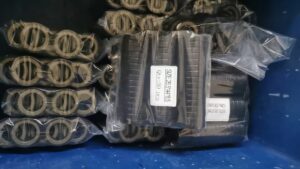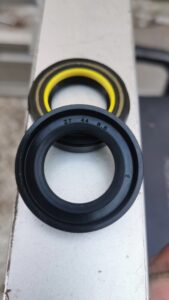Table of Contents
ToggleWhat Do Steering Rack Seals Do?
Steering rack seals are indispensable components in modern automotive steering systems, particularly in vehicles equipped with hydraulic power steering. These seals play a multifaceted role in ensuring safe, responsive, and reliable steering performance. Below is a detailed breakdown of their critical functions and operational significance.




1. Hydraulic Fluid Retention
Steering rack seals create a robust barrier between the steering rack’s moving components and its housing, ensuring power steering fluid remains contained within the system. Hydraulic fluid is the lifeblood of power steering, enabling the transfer of force from the steering wheel to the wheels. By retaining this fluid, the seals:
- Maintain consistent hydraulic pressure, which is vital for smooth steering assistance.
- Prevent fluid leaks that could lead to reduced steering responsiveness or complete system failure.
- Ensure optimal lubrication of internal components like the rack-and-pinion gears, minimizing friction and wear.
Without effective sealing, fluid loss would compromise steering ease, forcing drivers to exert significantly more effort to turn the wheel—a safety hazard, especially at low speeds.
2. Contamination Prevention
Steering rack seals act as gatekeepers, shielding the steering system’s internal mechanisms from external contaminants. Their design blocks:
- Dirt and debris from road surfaces.
- Moisture and water ingress, which can cause corrosion.
- Chemical residues (e.g., road salt, brake fluid) that degrade components.
Contaminants entering the steering rack accelerate wear on precision-machined parts such as gears and bearings. For instance, abrasive particles can score the rack shaft, while moisture promotes rust, leading to uneven steering or permanent damage. By sealing these vulnerabilities, the seals preserve the system’s integrity and longevity.
3. Pressure Management
Hydraulic power steering relies on controlled fluid pressure to amplify driver input. Steering rack seals ensure this pressure remains stable by:
- Preventing leaks that would depressurize the system.
- Accommodating pressure fluctuations during sharp turns or heavy loads.
- Maintaining a sealed environment for the hydraulic pump to operate efficiently.
High-quality seals, often made from nitrile rubber (NBR) or fluoroelastomers (FKM), withstand pressures exceeding 1,500 psi while resisting deformation. Advanced designs, such as dual-lip or multi-lip seals, enhance performance—one lip retains fluid, while others repel contaminants.
4. Dynamic Sealing Under Motion
Unlike static seals, steering rack seals must endure constant lateral movement as the rack shaft extends and retracts during steering. This dynamic operation demands specialized engineering:
- Lip seals: Flexible edges conform to the rack shaft’s surface, maintaining contact even during movement.
- O-rings: Provide supplementary sealing in high-pressure zones.
- Wear-resistant materials: Reduce friction between the seal and moving parts.
These features allow the seals to adapt to the rack’s motion without compromising sealing efficiency, ensuring smooth steering across thousands of cycles.
5. Temperature Resilience
Steering systems operate in extreme thermal conditions, from freezing winters to scorching engine bays. Steering rack seals are engineered to:
- Withstand temperatures ranging from -40°F to 300°F (-40°C to 150°C).
- Resist hardening, cracking, or softening due to thermal cycling.
- Maintain elasticity to accommodate component expansion/contraction.
Materials like FKM excel in high-heat environments, while NBR offers cost-effective performance in moderate climates.
6. Prolonging Component Lifespan
By preventing fluid leaks and contamination, steering rack seals indirectly extend the service life of entire steering systems, including:
- Power steering pumps: Avoid dry running caused by fluid loss.
- Rack-and-pinion gears: Reduced wear from debris-free lubrication.
- Tie rods and bushings: Protection from corrosive substances.
This preservation minimizes maintenance costs and delays the need for expensive overhauls.
Consequences of Seal Failure
Worn or damaged seals trigger a cascade of issues:
- Fluid leaks: Result in stiff steering, groaning noises during turns, and fluid puddles under the vehicle.
- Contamination ingress: Causes internal corrosion, uneven steering, and premature component failure.
- Complete power steering loss: A critical safety risk, especially in emergencies.
Timely replacement of degraded seals is crucial. Symptoms like stiff steering or visible leaks warrant immediate inspection.
Maintenance Best Practices
To maximize seal performance:
- Use manufacturer-recommended power steering fluid to avoid chemical incompatibility.
- Inspect seals during routine servicing for cracks, wear, or deformation.
- Replace seals proactively every 80,000–100,000 miles or at signs of deterioration.
Conclusion
Steering rack seals are unsung heroes in automotive safety and performance. They retain hydraulic fluid, block contaminants, manage pressure and temperature, and enable dynamic motion—all while extending the lifespan of critical steering components. Regular maintenance and prompt replacement of these seals ensure a vehicle remains responsive, efficient, and safe to drive. Understanding their role empowers drivers and technicians alike to prioritize this small yet vital part of the steering system.



Leave A Comment